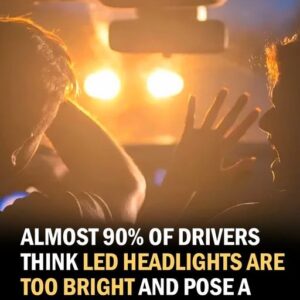In recent years, LED headlights have become a standard feature on most new vehicles, promising better road illumination and longer lifespan.
However, these bright lights have sparked widespread debate and frustration among drivers, many of whom believe their intensity poses serious safety concerns.
Recent studies and expert opinions suggest the issue goes beyond mere discomfort, potentially escalating into a public safety hazard.
The Growing Discontent on the Roads
 Credit: Unsplash
Credit: Unsplash
According to a survey commissioned by the RAC, 89% of UK drivers think LED headlights are excessively bright, with 85% reporting that headlight glare has worsened over time.
This sentiment is not confined to the UK; across the U.S., drivers are also raising concerns. Victor Morgan, a mechanical engineer, conducted his own tests and found real-world glare levels that far exceed regulatory limits.
LEDs: A Double-Edged Sword?
 Credit: Unsplash
Credit: Unsplash
LED headlights were introduced as a more efficient and durable alternative to traditional halogen bulbs.
While they offer improved visibility for the driver, they come with an unintended consequence: their concentrated beams can cause significant discomfort for oncoming traffic.
Mark Rea from the Light and Health Research Center points out that misaligned headlights exacerbate the problem, particularly for lower-sitting cars encountering SUVs or trucks. “It’s not every car,” he notes, “but about 20% are glaring“.
Unintended Consequences of Progress
 Credit: Unsplash
Credit: Unsplash
The transition to LED technology was initially welcomed, but the downsides quickly became apparent.
Many drivers report feeling blinded on dark roads, prompting some to wear specialized glasses for night driving.
The intense brightness often leads to slower reaction times, with two-thirds of drivers admitting they have to reduce their speed to cope.
Blame It on the Angle?
 Credit: Unsplash
Credit: Unsplash
Experts suggest that headlight misalignment plays a significant role in the problem.
Adaptive headlights, which adjust their beam direction based on the vehicle’s movements and surroundings, could offer a solution.
However, these advanced systems are not yet widely adopted, leaving many to rely on standard, often poorly aligned, LED setups.
Calls for Stricter Regulation
 Credit: Unsplash
Credit: UnsplashThe National Highway Traffic Safety Administration (NHTSA) recently received a petition to reevaluate the maximum brightness allowed for LED headlights.
Advocacy groups like the Soft Lights Foundation argue that current regulations fail to address the real-world impacts of these lights. “Everyone is mystified by why they are being blinded,” says Mark Baker, president of the foundation.
A Global Issue
 Credit: Unsplash
Credit: Unsplash
While complaints about LED headlights are prominent in the U.S., they resonate globally.
In the UK, a staggering 64% of drivers believe that these lights are so bright they could cause accidents.
The consistency of these concerns across different countries highlights the need for an international standard to mitigate the risks.
Potential Solutions on the Horizon
 Credit: Unsplash
Credit: Unsplash
Beyond regulatory adjustments, newer adaptive lighting technologies offer hope.
These systems can dynamically change the intensity and direction of light to minimize glare for other drivers.
However, widespread adoption is still years away. In the meantime, vehicle owners are encouraged to have their headlights checked and aligned regularly.
Final Thoughts
 Credit: Unsplash
Credit: Unsplash
LED headlights, once hailed as a technological breakthrough, now face mounting scrutiny. As more drivers voice their concerns, the need for regulatory reforms and technological advancements becomes clear. Whether through stricter standards or innovative solutions, the goal remains the same: ensuring safer and more comfortable roads for all.
News
NBA – Shaquille O’Neal (284M in career) admits: “I spent 1 million in 30 minutes going to…
The Big Podcast (DR) Shaquille O’Neal is one of the richest players in NBA history, thanks to his salaries in the league but also thanks to his…
What Are Eye Floaters? Here What To Do If you Start Seeing Them, According to an Eye Doctor
Eye floaters are a common yet often misunderstood visual phenomenon. Whether they appear as squiggly lines, specks, or cobwebs drifting across your vision, they can be concerning…
These 12 Children Proved Once Again That Any Child Can Be A Hero
Heroes Among Us: The Awesome Dozen Kids Aid Police It is universally acknowledged by those who witnessed the event that the group of children we are celebrating…
People who have this line on their hand are very special.
Palmistry is a form of divination that has been passed down from generation to generation. It was first used in China and India more than 5,000 years…
There’s a Woman in a Boat Riddle: Try to Solve the Viral Riddle
There is no shortage of education and entertainment. Thanks to smartphones, it’s all at our fingertips. Even with all the variety, spending a few minutes on riddles…
Astronaut shares the profound ‘big lie’ he realized after seeing the Earth from space
Have you ever heard of the overview effect? This refers to the perspective that astronauts experience when looking at the Earth from outer space. The effect is…
End of content
No more pages to load










